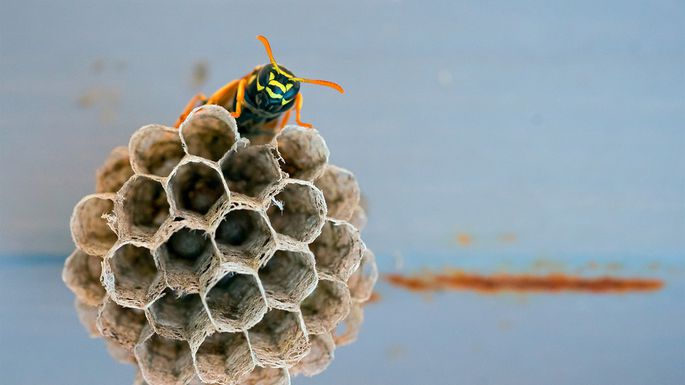You’re relaxing in your garden, sipping lemonade, when a few wasps decide to crash your party. Yikes! These buzzy invaders aren’t typically aggressive, but they will attack if their space is invaded—even if that space is your home. Wasps start nesting from late spring to midsummer. Once they establish their nest, they will come back to that location and become territorial. And once that nest is on your property, you have a big problem on your hands. The following tips will help you wasp-proof your house and eradicate any unwanted pests. To prevent an infestation, Michael Bentley, director of education and training for the National Pest Management Association, says potential entry points should be cut off by sealing all cracks and crevices, repairing any torn window or door screens, and keeping doors closed to prevent wasps from getting inside.Whip out your caulking gun and get to work on caulking joints and cracks in boards around the home, says Chris Murphy of Inman-Murphy Pest Control, in Millington, TN. Keep up garden maintenance
Too much vegetation around your home can provide ample opportunities for wasps to create nests and increase your chances of getting stung. “Keep hedges and shrubs trimmed to deter wasps from building nests and to make inspections for nests easier,” says Bentley. And watch out for holes in the ground. Claudio Salem, West market technical director for Western Exterminator, says if you notice holes or burrows in your yard, fill them in as soon as you can. “Wasps can take up residence in rodent, snake, or other animal burrows,” says Salem. Be careful when filling the holes, though, as doing so may make stinging pests fly out or become aggressive. If you have reasons to expect an infestation, this may be best left to a pest control professional. Minimize food sources Summertime picnics are a sure way to draw wasps to your fancy spread. In midsummer to early fall, wasp colonies become mature and more aggressive and are out actively hunting for food, says Salem. “Summer treats like sodas, juices, popsicles, and ice cream are packed full of sugar, which wasps love to eat. Unfortunately, these treats are frequently dropped or left behind outside. Be sure to clean up spills right away,” says Salem. To reduce wasp activity around your home, Bentley says to minimize available food sources that may attract foragers. “Any trash containers should be equipped with a tight-fitting lid to discourage wasps from foraging on discarded food and beverages that could continually attract stinging pests,” says Bentley. Make wood less appealing Paper wasps build nests using wood fiber. They can use old wood fences, damaged siding, and old tree bark. Salem says homeowners should paint or stain untreated wood to deter wasps from using it to build their nests. Water-damaged wood can also be a problem. Salem says it can become a shelter or food source for many different pests, and wasps find the larvae of many insects especially appetizing. By addressing water-damaged wood, you can rid your yard of other insect infestations and decrease the likelihood of wasps seeing your home as a buffet.
Find the nest Regularly inspect sheltered and protected areas where wasps are likely to build nests. Levi Brody of Brody Brothers Pest Control, in Owings Mills, MD, says paper wasps—the most common stinging pest he deals with—tend to build nests in and around human-made structures. He says they often find them nesting under deck furniture, flooring, and staircases. “They love to be inside barbecue grills, paper slots in mailboxes, basketball hoops, kid slides, metal piping, exterior lighting fixtures—just about any crack or crevice they can find,” says Brody. Bentley says yellow jackets construct subterranean nests, while bald-faced hornets and paper wasps like to nest above ground. “Bald-faced hornets construct bell-shaped nests that can be located in trees, tree holes, dense shrubs, or structures. Paper wasps construct umbrella-shaped nests commonly found hanging from objects like tree branches, porch ceilings, deck floor joists, and more,” he says. Use wasp freeze If you do find a nest, you’ll want to quickly wipe out the wasps. It’s always wise to call a wasp control specialist, but there are a few DIY eradication techniques. Brody says to use a jet spray found in hardware stores. Wasp Freeze, a specially formulated insecticide, works quickly so that no stinging pheromone is released, which reduces the possibility of stings. When using it, always wear protective equipment and follow the manufacturer’s instructions. Brody recommends treating at night because all of the wasps will be inside the nest. There can also be several queens, so if you miss one wasp, they can build the nest back up. Brody says if the nest is inside eaves and attics, it’s usually best to call in an expert.

